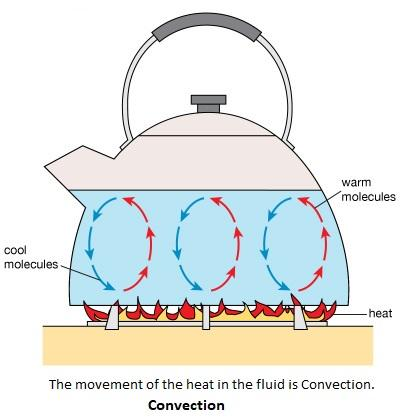
Define the process of convection.
Answer
567.6k+ views
Hint: In general, there are three types of heat transfer. They are conduction, convection and radiation. So, the heat is transferred from hot body to cold body by these three types. And these three types of heat transfer are different from one another.
Complete step by step solution:
Convection is the process of heat transfer from hot body to cold body by the bulk movement of the molecules within fluids such as gases and liquids. The initial heat transfer from the hot body to the fluid takes place through conduction, but the bulk heat transfer happens due to the motion of the fluid. Convection is the process of heat transfer in fluids by the actual motion of molecules in the fluids. It happens in liquids as well as gases. It may be natural or forced. It involves a bulk transfer of portions of the fluid.

There are two types of convection, and they are natural convection and forced convection. In natural convection, when the convection takes place due to the buoyant force as there is a difference in densities between the hot body and cold body caused by the difference in temperatures between the hot body and cold body it is known as natural convection. The examples of the natural convection are oceanic winds. In forced convection, when external sources such as fans and pumps are used to cool the hot body, it is known as forced convection.
Note: The phenomenon when the fluid particle of a medium moves to the source of heat energy and absorbs the heat energy and moves away from the heat body, so the next fluid particle of a medium moves to the source of heat energy. Convection is the phenomenon where the particle of matter moves and carries the heat.
Complete step by step solution:
Convection is the process of heat transfer from hot body to cold body by the bulk movement of the molecules within fluids such as gases and liquids. The initial heat transfer from the hot body to the fluid takes place through conduction, but the bulk heat transfer happens due to the motion of the fluid. Convection is the process of heat transfer in fluids by the actual motion of molecules in the fluids. It happens in liquids as well as gases. It may be natural or forced. It involves a bulk transfer of portions of the fluid.

There are two types of convection, and they are natural convection and forced convection. In natural convection, when the convection takes place due to the buoyant force as there is a difference in densities between the hot body and cold body caused by the difference in temperatures between the hot body and cold body it is known as natural convection. The examples of the natural convection are oceanic winds. In forced convection, when external sources such as fans and pumps are used to cool the hot body, it is known as forced convection.
Note: The phenomenon when the fluid particle of a medium moves to the source of heat energy and absorbs the heat energy and moves away from the heat body, so the next fluid particle of a medium moves to the source of heat energy. Convection is the phenomenon where the particle of matter moves and carries the heat.
Recently Updated Pages
Master Class 11 Business Studies: Engaging Questions & Answers for Success

Master Class 11 Computer Science: Engaging Questions & Answers for Success

Master Class 11 Maths: Engaging Questions & Answers for Success

Master Class 11 Chemistry: Engaging Questions & Answers for Success

Master Class 11 Economics: Engaging Questions & Answers for Success

Master Class 11 Accountancy: Engaging Questions & Answers for Success

Trending doubts
What is meant by exothermic and endothermic reactions class 11 chemistry CBSE

10 examples of friction in our daily life

One Metric ton is equal to kg A 10000 B 1000 C 100 class 11 physics CBSE

1 Quintal is equal to a 110 kg b 10 kg c 100kg d 1000 class 11 physics CBSE

Difference Between Prokaryotic Cells and Eukaryotic Cells

What are Quantum numbers Explain the quantum number class 11 chemistry CBSE




